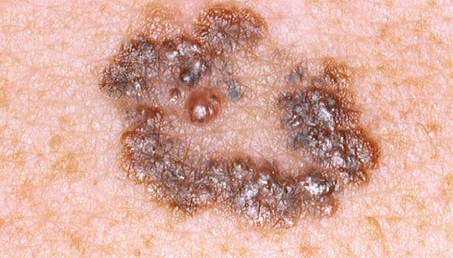Melanoma
For patient information click here
| Melanoma | |
 | |
|---|---|
| Melanoma malignum on the left leg of a 60-year-old woman | |
| ICD-10 | C43 |
| ICD-9 | 172 |
| ICD-O: | Template:ICDO |
| OMIM | 155600 |
| DiseasesDB | 7947 |
| MedlinePlus | 000850 |
| eMedicine | derm/257 |
Editor-In-Chief: C. Michael Gibson, M.S., M.D. [1] Please Join in Editing This Page and Apply to be an Editor-In-Chief for this topic: There can be one or more than one Editor-In-Chief. You may also apply to be an Associate Editor-In-Chief of one of the subtopics below. Please mail us [2] to indicate your interest in serving either as an Editor-In-Chief of the entire topic or as an Associate Editor-In-Chief for a subtopic. Please be sure to attach your CV and or biographical sketch.
|
Melanoma Microchapters |
|
Diagnosis |
|---|
|
Treatment |
|
Case Studies |
|
Melanoma On the Web |
|
American Roentgen Ray Society Images of Melanoma |
Overview
History
Epidemiology
The incidence of melanoma has increased in the recent years, but it is not clear to what extent changes in behavior, in the environment, or in early detection are involved.[1]
Causes
Risk factors
Pathophysiology
Diagnosis
- History and Symptoms | Physical Examination | Staging | Lab Tests | Electrocardiogram | X Ray | MRI | CT | Echocardiography | Other imaging findings | Other diagnostic studies
Treatment
Treatment of advanced malignant melanoma is performed from a multidisciplinary approach including dermatologists, medical oncologists, radiation oncologists, surgical oncologists, general surgeons, plastic surgeons, neurologists, neurosurgeons, otorhinolaryngologists, radiologists, pathologists/dermatopathologists, research scientists, nurse practitioners and physician assistants, and palliative care experts. Nurse practitioners (NPs) and physician assistants (PAs) are qualified to evaluate and treat patients on behalf of their supervising physicians. Treatment guidelines can be found through many resources available to health care professionals around the world. Inspired by melanoma’s increasing prevalence, researchers are seeking to understand the pathways that regulate melanin production.
Medical therapy | Surgical options | Primary prevention | Secondary prevention | Financial costs | Future therapies
Future thought
One important pathway in melanin synthesis involves the transcription factor MITF. The MITF gene is highly conserved and is found in people, mice, birds, and even fish. MITF production is regulated via a fairly straightforward pathway. UV radiation causes increased expression of transcription factor p53 in keratinocytes, and p53 causes these cells to produce melanoctye stimulating hormone (MSH), which binds to MC1R receptors on melanocytes. Ligand-binding at MC1R receptors activates adenyl cyclases, which produce cAMP, which activates CREB, which promotes MITF expression. The targets of MITF include p16 (a CDK inhibitor) and Bcl2, a gene essential to melanocyte survival. It is often difficult to design drugs that interfere with transcription factors, but perhaps new drugs will be discovered that can impede some reaction in the pathway upstream of MITF.
Studies of chromatin structure also promise to shed light on transcriptional regulation in melanoma cells. It has long been assumed that nucleosomes are positioned randomly on DNA, but murine studies of genes involved in melanin production now suggest that nucleosomes are stereotypically positioned on DNA. When a gene is undergoing transcription, its transcription start site is almost always nucleosome-free. When the gene is silent, however, nucleosomes often block the transcriptional start site, suggesting the nucleosome position may play a role in gene regulation.
Finally, given the fact that tanning helps protect skin cells from UV-induced damage, new melanoma prevention strategies could involve attempts to induce tanning in individuals who would otherwise get sunburns. Redheads, for example, do not tan because they have MC1R mutations. In mice, it has been shown that the melanin-production pathway can be rescued downstream of MC1R. Perhaps such a strategy will eventually be used to protect humans from melanoma.
References
- ↑ Berwick M, Wiggins C. "The current epidemiology of cutaneous malignant melanoma". Front Biosci. 11: 1244–54. PMID 16368510.
External links
Websites
- Melanoma Molecular Map Project
- Proleukin
- Melanoma Perspectives
- Information on Melanoma from The Skin Cancer Foundation
- CIMIT Center for Integration of Medicine and Innovative Technology - New Advances and Research in Melanoma
- Sunbathing helps prevent cancer: UK newspaper article
- Melanoma International Foundation
- Melanoma Education Foundation
- melanoma.com (commercially supported site)
- DermNet NZ: Melanoma
- Professional melanoma information
- Adelaide Melanoma Unit (free information on diagnosis, prevention, treatment of melanoma; booklet available at cost)
- Assessing health risks of sunbeds and UV exposure summary by GreenFacts of the European Commission SCCP assessment
Patient information
- What You Need To Know About Moles and Dysplastic Nevi - patient information booklet from cancer.gov (PDF)
- MPIP: Melanoma patients information page
- Melanoma Support Organisation (Victoria, Australia) - Ran by Melanoma Sufferers with strong links to Cancer Institutes in Victoria, Australia
- Melanoma Patients Australia
- Mikes Page - The Melanoma Resource Center
- MEL-L - Melanoma e-mail list for patients, caregivers and healthcare professionals - Supporting the Melanoma Patient since 1996
Images, photographs
- Melanoma photo library at Dermnet
- DermAtlas: Melanoma images
- Photographs of melanoma
- Skin imaging methods for melanoma diagnosis(commercial advertising)
- Pictures of melanomas
- Pictures of amelanotic melanomas
Videos
- Health Video: Melanoma and Non-Melanoma Skin Cancers - Overview, Prevention, and Treatment
- Health Video: How to Perform a Skin Self Exam
be-x-old:Мэлянома bg:Меланома ca:Melanoma da:Malignt melanom de:Malignes Melanom et:Melanoom gl:Melanoma maligno it:Melanoma he:מלנומה la:Melanoma Malignus nl:Melanoom no:Malignt melanom sr:Меланом fi:Melanooma sv:Malignt melanom